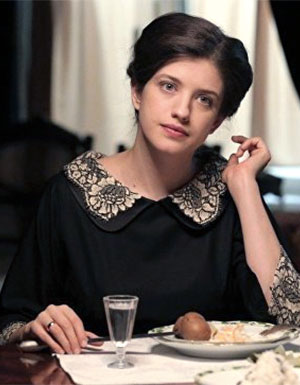“The Road to Calvary” kept popping up in my Netflix feed. I knew the historical series was set during World War I, but I assumed, from the series’ photo of a beautiful young woman wearing a stylish hat and a striking baby blue dress, that it would be light on the war scenes, heavy on the drama. Just what I was in the mood for.
To help keep this site running: Willow and Thatch may receive a commission when you click on any of the links on our site and make a purchase after doing so.
In the first minute, we see an assembly of agitated men, soldiers on horseback, others firing into the crowd, then more violence. Keep going, I tell myself, and I’m so happy I did. Rioting Saint Petersburg is on the brink of great revolution, but suddenly the scene is gone, and we are in a luxurious sunlit home. Two sisters are reuniting, and there’s so much joy between them.
The story of “The Road to Calvary” is a powerful anti-war sentiment told through the interwoven lives of its characters, with a focus on two sisters of noble birth. Swept up in political unrest during World War I, Dasha and Katya cope with turbulent romances as Russian history is made around them.
Throughout each of the 12 episodes of the series (rated TV-14), based on the eponymous epic of the Soviet writer Alexei Tolstoy, the acting, settings and costumes are unwavering in their excellence. The scope of “The Road to Calvary” is so epic it’s hard to fathom how it was made.
The series stars Yuliya Snigir, Anna Chipovskaya, Leonid Bichevin, and Pavel Trubiner, but you likely won’t recognize any of them (unless you’ve seen Snigir in “A Good Day to Die Hard”), and that doesn’t matter. All are immediately relatable. There are no minor characters, and everyone’s saga is superbly told without losing focus on the central characters.
“The Road to Calvary” is suffused with the dramatic tension of narrow escapes, and the relief of friends and strangers who support each other. There are battle scenes, and hard to watch, heartbreaking moments. But as a viewer, what I found most difficult is that I needed to know what would happen to everyone, but I didn’t want the show to end.
“The Road to Calvary” is in Russian with English subtitles, but for those of you who avoid movies because they are subtitled, allow me a prediction: this is where you make your peace with them. You’ll be so absorbed in the drama that you’ll stop minding.
In her review below, J’nell Ciesielski gives us “5 Reasons to Watch The Road to Calvary,” a universal story about love, life and the wars in Russia in the years between 1914 and 1919. – Willow and Thatch
The History
This 2017 screen adaptation, based on “Sisters,” the first part of Alexey Tolstoy’s trilogy “The Road to Calvary,” marks the October Revolution’s centenary. Russia has a rich culture filled with powerful rulers, tragic dynasties, passionate literature, and a people forged of steel and ice. But it is also a culture of class division and opposing politics.
In the period series, all different aspects of life in circa 1914 Russia are represented: stations in life, ideologies, dreams, social expectations, and prejudices. We glimpse the regal beauty of Imperial Russia and its nobles, the thirst for truth by artists, and the scrounging existence of the poor as the world teeters on the brink of war. We are given the opportunity to experience the volatile changes as they come about and see how they affect everyone, down to the last child. There are still lasting impacts to this day.
The expectation of change, World War I, the Revolution, the hope for better life and the Civil War are the main milestones of the film. Many of the events and characters populating the storyline are fictionalized, but “The Road to Calvary” gives an accurate portrayal of Russia and its civil upheaval at this time. The series will likely inspire viewers to do some research of their own, to shed more light on how the mighty country was shaken to its core.
The Sisters
Dasha and Katya’s story reflects Russia’s national tragedy between 1914 and 1919, and it makes “The Road to Calvary” an unforgettable viewing experience.
Raised as privileged ladies, their entire way of life crumbles beneath them as the Bolsheviks topple the Tsarist autocracy and force them to find their way amidst the shifting sands of politics and love. As they navigate the atrocities of the Russian Revolution, the sisters are forced down different paths that converge and swerve, but their devotion to each other never fails. They are each other’s hope for survival with a bond unbreakable by men, explosions, zealot kidnappers, or betrayal from their own father. Everything conspires against them, but they are sustained by the hope of reuniting.
This bond is the heart, and force of life that carries the historical drama. The narrative of the war acts as a backdrop to their relationship, and even viewers with little interest in the politics of war can enjoy the story.
The Emotions
“The Road to Calvary” gives you all the feels. It makes you laugh, sigh, cry, clap, soak in culture and question why you weren’t born in a time gone by – even one as tumultuous as this.
In the first episode we’re dropped straight into opulent pre-war Russia where the Bulavina sisters, Dasha and Katya, are the thing around town. Beautiful, educated, and born into the privileged circles, they float between parties and poetry readings until the zealots begin flouting rebellion speeches on the factory floors and university podiums.
The revolution ushers in swift adversity and our characters are plunged into the chaos of the changing times. Men transform into soldiers and take up sides against one another, and women learn to fight for their own survival on the homefront. Those caught between wish to see nothing ugly of the war, but the profits they can make for themselves.
When the characters are forced to make heartbreaking decisions, we see the effects ripple through their lives, and it makes them real to us. As the viewer, we have the advantage of seeing the story as a whole, knowing how all its different threads weave together, in a way not possible for the individual characters. We can put ourselves in their shoes and empathize with their choices, but our wider perspective means we dare to dream for them, when they cannot.
The Red, White, and Green of War
War consumes all in its path, forcing people to choose sides, and this makes for engrossing, non-stop drama in “The Road to Calvary.” Exhausted from suffering under an elitist regime, the working classes banded together to form the Reds, known as the communist Bolsheviks. They opposed the Whites, who greatly favored nationalism and monarchism. The two ideological giants clashed in a war of the old and the new, threatening to trample those left wavering in between.
Those in the middle not content to wait for the inevitable, tired of the Red Army requisitioning their livestock, food, and able-bodied men, formed a third party. The Green Army rose from the peasant ranks to protect their communities, and fight against all governments, during the civil war.
In “The Road to Calvary,” we care about everyone – the Reds, the Whites, and the Greens, but especially Ivan Ilyich Telegin, our protagonist, the epitome of balance in a chaotic time. Strong, brave, loyal, and kind, he wants nothing more than to settle down with the love of his life, while remaining friends with everyone and enemies of none. Ivan finds himself in the difficult situation of choosing a side, and when he does, it is merely out of loyalty to his friend. And it’s loyalty that keeps him whole, while others falter around him in the ebb and flow of battle.
The Love
More than a story about war, “The Road to Calvary” is about the different kinds of love. There is sisterly love between Dasha and Katya, love of friends between the retired military commander and his Jewish neighbor, and love of country, art, ideals.
But the biggest illustrations of love are told within the Bulavina sisters’ relationships. Katya struggles to find love until “the one” crosses her path. It’s love at first sight, but they have to fight to be together. When they are thrown into the fires of desperation, Katya finds her strength, and the man she loves will brave the implosion of Russia to get back to her.
Dasha and Ivan’s relationship is a leap into the heady flames of love, but Dasha is slow to realize how good a man Ivan is. Just when she fully opens her eyes, their love is tested by the horrors of war. We are swept away by the tender moments along their journey, but also by ones that tear at our hearts. Dasha and Ivan are two incomplete halves seeking to find a whole together. And they just might.
She’s the author of Among the Poppies, a “powerful story of battlefield love” (Publishers Weekly), and her latest release, The Songbird and the Spy, a story of romance behind the lines of occupied France.
Winner of the Romance Through the Ages contest and Maggie Award, J’nell can often be found dreaming of a second home in Scotland, indulging in chocolate of any kind, or watching old black and white movies. Born a Florida girl, she now calls Virginia home, along with her very understanding husband, young daughter, and one lazy beagle. You can learn more about J’nell Ciesielski at her website.
If you enjoyed this post, wander over to The Period Films List. You’ll especially like the Best Period Dramas: First World War Era List.

